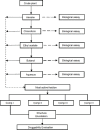Drug discovery from plant sources: An integrated approach
- PMID: 23049178
- PMCID: PMC3456845
- DOI: 10.4103/0974-8520.100295
Drug discovery from plant sources: An integrated approach
Abstract
New drug discovery is facing serious challenges due to reduction in number of new drug approvals coupled with exorbitant rising cost. Advent of combinatorial chemistry provided new hope of higher success rates of new chemical entities (NCEs); however, even this scientific development has failed to improve the success rate in new drug discovery. This scenario has prompted us to come out with a novel approach of integrated drug discovery, where Ayurvedic wisdom can synergize with drug discovery from plant sources. Initial steps in new drug discovery involve identification of NCEs, which can be either sourced through chemical synthesis or can be isolated from natural products through biological activity guided fractionation. The sources of many of the new drugs and active ingredients of medicines are derived from natural products. The starting point for plant-based new drug discovery should be identification of the right candidate plants by applying Ayurvedic wisdom, traditional documented use, tribal non-documented use, and exhaustive literature search. Frequency analysis of the ingredients of the ancient documented formulations and analysis of their Ayurvedic attributes may provide an in-depth idea of the predominance of particular Ayurvedic characteristics based on which appropriate candidate plants may be selected for bioactivity-based fractionation. The integration of Ayurvedic wisdom with drug discovery also brings the need for a paradigm shift in the extraction process from sequential to parallel extraction. Bioassay-guided fractionation of the identified plant may lead to standardized extract or isolated bioactive druggable compound as the new drug. This integrated approach would lead to saving of cost and time, coupled with enhanced success rate in drug discovery.
Keywords: Ayurveda; biological activity; drug discovery; extraction; fractionation; plant.
Figures
References
-
- Harvey AL. Natural products in drug discovery. Drug Discov Today. 2008;13:894–901. - PubMed
-
- Mahidol C, Ruchirawat S, Prawat H, Pisutjaroenpong S, Engprasert S, Chumsri P, et al. Biodiversity and natural product drug discovery. Pure Appl Chem. 1998;70:2065–72.
-
- Koehn FE, Carter GT. The evolving role of natural products in drug discovery. Nat Rev Drug Discov. 2005;4:206–20. - PubMed
-
- Ehrman TM, Barlow DJ, Hylands PJ. Phytochemical databases of chinese herbal constituents and bioactive plant compounds with known target specificities. J Chem Inf Model. 2007;47:254–63. - PubMed
-
- Lipinski CA, Lombardo F, Dominy BW, Feeney PJ. Experimental and computational approaches to estimate solubility and permeability in drug discovery and development settings. Adv Drug Deliv Rev. 2001;46:3–26. - PubMed
LinkOut - more resources
Full Text Sources
Other Literature Sources





